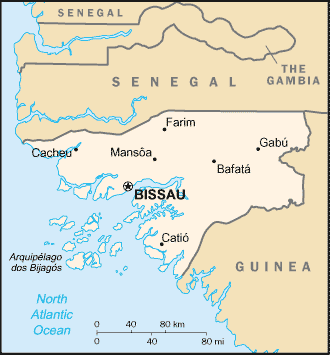Map:

Overview:
Since independence from Portugal in 1974, Guinea-Bissau has experienced considerable upheaval. The founding government consisted of a single party system and command economy. In 1980, a military coup established Joao VIEIRA as president and a path to a market economy and multiparty system was implemented. A number of coup attempts through the 1980s and early 1990s failed to unseat him and in 1994 he was elected president in the country's first free elections. A military coup attempt and civil war in 1998 eventually led to VIEIRA's ouster in 1999. In February 2000, an interim government turned over power when opposition leader Kumba YALA took office following two rounds of transparent presidential elections. YALA was ousted in a bloodless coup in September 2003, and Henrique ROSA was sworn in as President. Guinea-Bissau's transition back to democracy will be complicated by its crippled economy, devastated in the civil war.
The People:
Population: 1,416,027 (July 2005 est.)
Age structure:
0-14 years: 41.5% (male 293,280/female 294,483)
15-64 years: 55.5% (male 376,719/female 409,402)
65 years and over: 3% (male 17,865/female 24,278) (2005 est.)
Religions:
indigenous beliefs 50%, Muslim 45%, Christian 5%
Government Type:
republic, multiparty since mid-1991
Leader(s) to pray for:
chief of state: President Henrique ROSA (interim; since 28 September 2003); note - a September 2003 coup overthrew the elected government of Kumba YALA; General Verissimo Correia SEABRA served as interim president from 14 to 28 September 2003
head of government: Prime Minister Carlos GOMES Junior (since 9 May 2004)
Source: The World Factbook
View All Countries